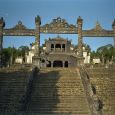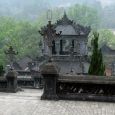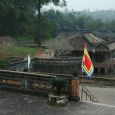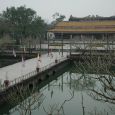Hue
Advertisement
By plane
Hue's international "Phu Bai" airport fields daily flights to and from Ho Chi Minh City and Hanoi, but flights are quite often disrupted by poor weather during the rainy season (Mid October - Mid December). The majority of flights are Vietnam Airlines but Jetstar Vietnam also runs a flight or two from Ho Chi Minh City and once a day to Hanoi. The airport is 15 kilometers away from the city center and should cost no more than 180,000VND by taxi . There is also a bus that will take you into the city & even drop you at your hotel for 45,000VND. The airport facility is currently undergoing renovations and will be closed until 13 June, 2011.
By train
Several trains a day to Hanoi, Ho Chi Minh City, Danang (4 hours) etc. The journey down south through Lang Co and the Hai Van Pass is particularly scenic, and from Danang you can take a taxi or motorbike to Hoi An.A second-class sleeper ticket from Ho Chi Minh City on the much superior 'express' SE2-SE6 train to Hue costs between 588,000 & 740,000 dong depending on the level you're on (1,2 or 3). Be warned the beds are quite hard, as there is not much of a matress (about half an inch thick), and it is placed over a plastic bench/seat. You can get other train types, but the little extra you pay is worth it several times over. It offers a wonderful travel experience. The traveler gets to sit, lie and sleep in a very small cabin for 23 hours with five other people (nearly always Vietnamese), eat four plain but tasty and filling Vietnamese meals, listen to a fine selection of Vietnamese pop songs on the PA, and see some incomparably beautiful countryside, particularly in the last section between Da Nang and Hue. It's an excellent way to see the country and meet ordinary Vietnamese, who are unfailingly friendly and helpful, even to travelers who have not bothered to learn a word of their language. The trip is especially recommended if you like babies.
By bus
Public buses from all the bigger cities connect to the main bus station . Most open tour buses include Hue in their itinerary, connecting to Hoi An or Da Nang to the south (4-6 hours) and Hanoi to the north (13-16 hours). The overnight Hanoi route is popular with locals, but beware of motion sickness among them.
Tombs of the Emperors
The other great attractions in Hue are the Tombs of the Emperors, which are located along the Perfume River south of the city. They are accessible by taxi or bike from the city, but the best way to see them is to hire a river boat and go for a cruise. Plan to make a full day of it.
Ngo Mon
The main southern entrance to the city, built in 1833 by Minh Mang. The central door, and the bridge connecting to it, were reserved exclusively for the emperor. Climb up to the second floor for a nice view of the exquisite courtyard. The Ngo Mon Gate is the principal entrance to the Imperial Enclosure. The Emperor would address his officials and the people from the top of this gate.
Tomb of Minh Mang
Tomb of Minh Mang is in this opulent complex, the main buildings are arranged on an east-west axis, including a courtyard surrounded by warrior statues and several temples and pavilions. Several bridges cross two lakes before the axis ends before the vast burial mound . The mausoleum features large gardens and lakes: a pleasant place to sit and relax. If you're dropped off by boat note that there is a stretch of souvenir sellers to navigate during the short walk to the mausoleum entrance.
Tomb of Khai Dinh
This is the best preserved of the lot and, while comparatively compact, quite grand at first sight. While it follows the classic formula of forecourts leading up to the tomb of the Emperor, complete with statues in attendance, architecture buffs will spot some European influences. The tomb itself is completely over the top with incredibly detailed and opulent mosaics of cavorting dragons. Try to get to this one early, as it is a favorite stop for Asian tour-bus groups. Also, you may want to leave the tourist path and head up the hill on the right side of the tomb, where a small temple stands. You will have a great view of the tomb and the valley it faces.
Tomb of Thieu Tri
Tomb of Thieu Tri was built in 1848. This Emperor and his wife were the most revered and loved throughout the country. Although he only ruled for 7 years, he was the most sorely missed. In a time of strife and economic problems, he was careful with the country's Treasury and made sure to improve his people's living standards. His last will was that he be placed in a tomb that was not extragavant, parting ways with the tradition of creating lavish final resting places for their Emperors.
Tomb of Tu Duc
Tomb of Tu Duc was Constructed from 1864 to 1867, the complex served as a second Imperial City where the Emperor went for "working vacations". Tu Duc's contemplative nature and poetic spirit is reflected in the landscape and arrangement of the 50 buildings that at one time stood here. A vast, sprawling complex set around a lake, with wooden pavilions and tombs and temples dedicated to wives and favored courtesans . The courtesans' quarters are in ruins, with only outlines and crumbling walls left amid waves of overgrown grass and silence, but other areas are stunningly well-preserved. The Emperor's tomb itself, tucked away in the back, is surprisingly modest - the final courtyard is nearly empty with just a stone coffin in the middle.
April - October





